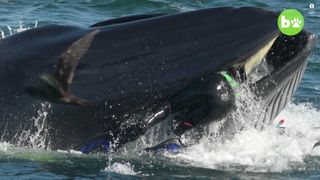What a Fluke! Man Ends Up in Whale's Mouth

While photographing a mass of sardines off South Africa's coast last month, a dive tour operator ended up on the wrong side of a whale — the inside.
Rainer Schimpf, 51, was in the water with a "bait ball," a swirling school of sardines surrounded by predators, when he suddenly felt the world go dark. He quickly realized he'd been scooped up by a whale, he told The Today Show.
"I held my breath," he said in an interview with Today, expecting the whale to pull him down. "I mean there was no other thing I could do," he added. "I mean, you can't fight a 15-ton animal." [8 Human-Animal Encounters That Went Horribly Wrong]
Whale encounter
Fortunately, the whale was likely as displeased about the situation as Schimpf and spit the swimmer out within a couple of seconds. Photographer Heinz Toperczer, who was working aboard a nearby boat, captured an amazing photo of Schimpf halfway inside the whale's mouth above the waterline, with only the diver's lower body dangling out. Live Science was unable to reach Schimpf for comment, but it seems that neither Schimpf nor the whale saw each other before one ended up in the other's mouth.
The whale was a Bryde's whale, pronounced Broo-dah's. These animals range throughout tropical and subtropical waters worldwide, said Tom Jefferson, a biologist and member of the scientific advisory board for Save the Whales. They're not so well-known, in part because they don't venture into polar regions and thus were never widely hunted by whalers, Jefferson said. Around South Africa, these whales average around 43 to 45 feet (13.1 to 13.7 meters) in length.
Despite the inevitable comparisons to the Biblical story of Jonah, Schimpf was never in danger of being swallowed by the whale, said Uko Gorter, the president of the American Cetacean Society. Bryde's whales are batch feeders. They lunge forward into schools of small fish, take in a wiggling mouthful of fish and water, and then strain the water back out through their floppy baleen plates before swallowing the remaining fish. Their throats are too small to swallow a human, Gorter told Live Science, though some baleen whales have been documented to accidentally swallow small birds.
Humpback whales, he said, have been found with Cassin's auklets in their stomachs, but those birds grow to only about 9 inches (23 centimeters) long.
Sign up for the Live Science daily newsletter now
Get the world’s most fascinating discoveries delivered straight to your inbox.
Gentle giants
Though being scooped up by a whale was a new experience for Schimpf, it may have been old hat for the whale, Jefferson said. Because bait balls attract a lot of predators in a small area, it's likely the Bryde's whales accidentally scoop up inedible animals fairly often, he said. Perhaps prior experience is why the whale didn't hesitate to spit Schimpf out.
The only whale that would likely be capable of swallowing a human would be a toothed whale, the sperm whale, which eats prey such as giant squid. A sperm whale did ram and sink the whale ship Essex in 1820, but there are no reliable reports of a sperm whale ever eating a human. The only such report found floating around early 1900s newspapers involved the unlikely story of a sailor surviving 36 hours in a sperm whale's stomach, and that account proved, upon investigation in 1991, to be a fish tale.
While the incident off South Africa was clearly an accident on both man's and whale's part, the lure of going viral with photographs and video has often brought people much too close to whales, noted Maris Sidenstecker, the co-founder of Save the Whales. Divers, swimmers and boaters should admire from a distance, Sidenstecker told Live Science, to ensure that whales can feed, rest and nurture their young without interruption.
- In Photos: Tracking Humpback Whales
- Image Gallery: Mysterious Lives of Whale Sharks
- Image Gallery: Russia's Beautiful Killer Whales
Originally published on Live Science.

Stephanie Pappas is a contributing writer for Live Science, covering topics ranging from geoscience to archaeology to the human brain and behavior. She was previously a senior writer for Live Science but is now a freelancer based in Denver, Colorado, and regularly contributes to Scientific American and The Monitor, the monthly magazine of the American Psychological Association. Stephanie received a bachelor's degree in psychology from the University of South Carolina and a graduate certificate in science communication from the University of California, Santa Cruz.
Most Popular

